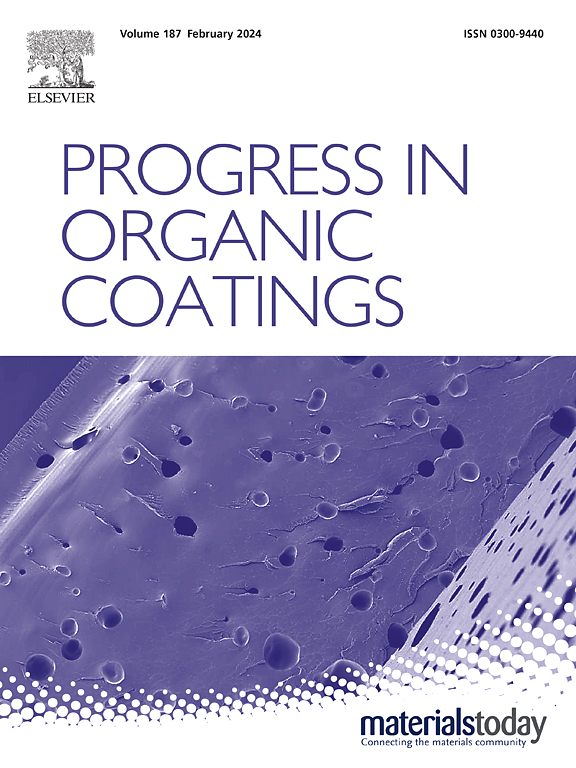Fabrication and characterization of a transparent, hydrophilic, and self-cleaning polyurethane coating on glass with a silica buffer layer and Ag₃PO₄/TiO₂ nanocomposite
IF 6.5
2区 材料科学
Q1 CHEMISTRY, APPLIED
引用次数: 0
Abstract
Self-cleaning coatings have attracted considerable interest in recent decades due to their potential to reduce maintenance costs and enhance surface durability. Among the various strategies, hydrophilic coatings incorporating metal oxides utilize the photocatalytic effects to remove organic contaminants via solar-assisted chemical degradation and water sheeting mechanisms. In this study, a polyurethane (PU)-based self-cleaning coating was fabricated by integrating Ag₃PO₄/TiO₂ (APT) nanocomposites into the PU matrix. Ag₃PO₄ was selected for its high photocatalytic activity under visible light, while TiO₂ was added to improve photostability and suppress electron-hole recombination. To enhance optical clarity and mechanical adhesion, a SiO₂ interlayer was first deposited onto glass substrates using the sol-gel method followed by dip-coating. Subsequently, the PU@APT top layer was applied via dip-coating, maintaining an immersion and withdrawal rate of 200 mm/min at a 90° dipping angle. APT nanocomposites with varying TiO₂ content—10 wt%, 30 wt%, and 50 wt%—were synthesized, yielding three formulations: APT10, APT30, and APT50. Comprehensive characterization was conducted using X-ray diffraction (XRD), Attenuated total Reflectance-Fourier transform infrared (ATR-FTIR), field emission scanning electron microscopy (FESEM), photoluminescence (PL) spectroscopy, Electrochemical impedance spectroscopy (EIS) and UV–Vis diffuse reflectance (DRS). Hydrophilicity was assessed via water contact angle (WCA) measurements, while surface roughness was evaluated using Atomic Force Microscopy (AFM). Photocatalytic performance was quantified through methylene blue (MB) dye degradation under visible light irradiation. Among the developed coatings, the SiO₂-PU@APT30 exhibited optimal performance, achieving 58 % MB degradation within 3 h, significantly outperforming the SiO₂-PU@TiO2 and Si-PU@Ag3PO4, which showed only 16 % and 31 % degradation, respectively. The observed enhancement is attributed to the synergistic interaction between Ag₃PO₄ and TiO₂, facilitating improved charge separation and photocatalytic efficiency. The SiO₂-PU@APT30 coated glass achieved an impressive transmittance of 86 %. By facilitating the formation of a uniform water film instead of droplets, it effectively prevents fog accumulation, providing a significant advantage over uncoated glass. Additionally, the final coating exhibited excellent hydrophilicity, with the water contact angle (WCA) significantly reduced from approximately 63° to 27° and after 30 min of visible light exposure, completely prevents condensation and droplet formation, demonstrating superior antifogging performance compared to bare glass. This, combined with its outstanding anti-fogging performance and superior photocatalytic activity, highlights its potential as an efficient and effective self-cleaning surface treatment.
含硅缓冲层和Ag₃PO₄/TiO₂纳米复合材料的透明、亲水性、自清洁聚氨酯玻璃涂层的制备与表征
近几十年来,由于具有降低维护成本和提高表面耐久性的潜力,自清洁涂层引起了相当大的兴趣。在各种策略中,包含金属氧化物的亲水涂层利用光催化效应通过太阳能辅助化学降解和水膜机制去除有机污染物。本研究将Ag₃PO₄/TiO₂(APT)纳米复合材料整合到聚氨酯(PU)基体中,制备了一种聚氨酯(PU)基自清洁涂层。选择Ag₃PO₄是因为它在可见光下具有较高的光催化活性,而加入TiO₂是为了提高光稳定性和抑制电子-空穴复合。为了提高光学清晰度和机械附着力,首先使用溶胶-凝胶法将SiO₂夹层沉积在玻璃基板上,然后使用浸渍涂层。随后,通过浸涂方式涂覆PU@APT顶层,在90°倾角下保持200 mm/min的浸出速率。合成了不同tio2含量(10 wt%、30 wt%和50 wt%)的APT纳米复合材料,得到了三种配方:APT10、APT30和APT50。采用x射线衍射(XRD)、衰减全反射-傅里叶变换红外(ATR-FTIR)、场发射扫描电镜(FESEM)、光致发光(PL)光谱、电化学阻抗谱(EIS)和紫外-可见漫反射(DRS)等方法进行了综合表征。亲水性通过水接触角(WCA)测量来评估,表面粗糙度使用原子力显微镜(AFM)来评估。通过亚甲基蓝(MB)染料在可见光照射下的降解,对其光催化性能进行了量化。在所开发的涂层中,SiO₂-PU@APT30表现出最佳性能,在3 h内达到58%的MB降解,显著优于SiO₂-PU@TiO2和Si-PU@Ag3PO4,后者分别只有16%和31%的降解。观察到的增强是由于Ag₃PO₄和TiO₂之间的协同作用,促进了电荷分离和光催化效率的提高。SiO₂-PU@APT30涂层玻璃达到了令人印象深刻的86%的透光率。通过促进形成均匀的水膜而不是水滴,它有效地防止了雾的积累,提供了比未涂膜玻璃显著的优势。此外,最终涂层表现出优异的亲水性,水接触角(WCA)从大约63°显著降低到27°,在可见光照射30分钟后,完全防止冷凝和液滴形成,与裸玻璃相比,表现出优越的防雾性能。这一点,结合其出色的抗雾性能和优越的光催化活性,突出了其作为高效和有效的自清洁表面处理的潜力。
本文章由计算机程序翻译,如有差异,请以英文原文为准。
求助全文
约1分钟内获得全文
求助全文
来源期刊

Progress in Organic Coatings
工程技术-材料科学:膜
CiteScore
11.40
自引率
15.20%
发文量
577
审稿时长
48 days
期刊介绍:
The aim of this international journal is to analyse and publicise the progress and current state of knowledge in the field of organic coatings and related materials. The Editors and the Editorial Board members will solicit both review and research papers from academic and industrial scientists who are actively engaged in research and development or, in the case of review papers, have extensive experience in the subject to be reviewed. Unsolicited manuscripts will be accepted if they meet the journal''s requirements. The journal publishes papers dealing with such subjects as:
• Chemical, physical and technological properties of organic coatings and related materials
• Problems and methods of preparation, manufacture and application of these materials
• Performance, testing and analysis.
 求助内容:
求助内容: 应助结果提醒方式:
应助结果提醒方式:


